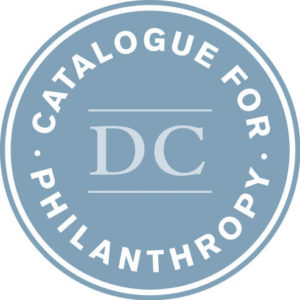
Catalogue for Philanthropy
The Catalogue for Philanthropy believes in the power of small nonprofits to spark big change and works everyday to create a more equitable, more just DC region. Learn more about their work at cfp-dc.org.
Why are we doing the work we’re doing, and how can we align the way we do our work with our values?
We explored this question during our National Small Nonprofit Summit. Across two days and 14 sessions, the Catalogue for Philanthropy and its partners explored answers to this question in all the topics important to nonprofit professionals—fundraising, board management, communications, and more.
As we enter the third year of the pandemic, funders and supporters are beginning to ask nonprofits about their plans for growth. Traditionally, an “acceptable” understanding of growth looks like more money, greater visibility, and bigger numbers. We know that none of these metrics necessarily translate to deeper impact.
At the same time, when the Catalogue surveyed local nonprofit Executive Directors last year, 40% of them said they were experiencing burnout and another 40% felt like they were on their way to burnout. 75-80% of them thought their teams were experiencing burnout and exhaustion. These responses tell us that while donors may expect nonprofits to expand, it is important for those in the nonprofit sector to challenge the underlying assumptions that define what growth can look like and to value sustainability and rest just as much as growth.
It’s time for us to rethink growth so that every step we take for our organization advances and practices our values. The following takeaways from this year’s Summit offer some starting points that we can consider.
Create and use a values-based grid: On a spreadsheet, list your values in rows—one on each row. Then, break down your programs, services, and operations by column. Have your staff apply each of your organizational values across the columns to examine what aligns and what doesn’t. For example, how do you practice your values when hiring staff, implementing your programs, or stewarding donors? Continually refresh and return to this grid to improve your workflows and guide any growth decisions you need to make. Also ensure that you check in with everyone on your team so that you can address multiple perspectives and work towards getting everyone on the same page.
Involve all sides of leadership when setting goals: Listen to the community you serve when you’re developing goals and setting strategies for your organization. Value the input of everyone who engages with your nonprofit—not just your board and donors, but also your staff and volunteers.
Organize a staff retreat: If you have not held a staff retreat since before 2020, consider renewing conversations about your organizational values and team culture. This is especially important because your staff will likely have different perspectives and opinions given the last two years. It is likely that you even have new staff! Get everyone energized and onboard with a retreat. This could be particularly helpful for integrating any staff you virtually onboarded into a team culture that may have been cultivated pre-pandemic.
Build community with your peers: Reach out to your network and find peer nonprofit leaders so you can help keep each other accountable. It is easy to get overwhelmed by the day-to-day tasks and lose sight of how you want to live your values, both in your work and personally. Being a part of the community allows you to prioritize this work and gives you a support system to strengthen your commitment.
Evaluate the way you measure and communicate impact: Remember that the true impact of your work often lies behind the numbers. While tangible outputs are helpful communication tools, stories are a powerful way to connect your organization’s mission and values with your work. Rather than increasing the scale of your outputs, consider conveying the human moments that show why your work is important. Before deciding on how you’ll grow as an organization, gauge the strengths of your programs and be honest about your capacity to maintain these strengths while growing.
Appreciate and invest in your staff: Create spaces for your staff to vocalize their needs and pay attention to these needs. Encourage your staff to take time off, and to take their lunches every day away from their screens. Be mindful of how you communicate, such as by scheduling your emails to send during work hours. Take some extra time to get to know your team and personalize the investments you make in each team member’s professional development journeys. Clearly communicate to your staff that you encourage and, where possible, financially support them in pursuing professional development opportunities.
Consider how your values are embedded in the language you use: Are you telling your community’s stories in ways that treat them with dignity and respect? In your messaging, do you use language that centers your community instead of language that frames your donors as “saviors”? Examine the specific words and phrases in your writing, whether it be a grant application or social media caption, to ensure that your communications align with, and clearly affirm, your values.
But Don’t Stop Here
In addition to these starting points, the National Small Nonprofit Summit covered other actionable advice on fundraising, communicating your organization’s mission, engaging your staff, recruiting board members, and more—all in ways that deeply embed your values. Gain these tips and ideas at the Summit website, where session recordings and slides are available to everyone at no cost.
If you’re interested in further resources, you can also register for a digital Learning Commons membership. Your membership will provide exclusive access to the Catalogue for Philanthropy’s online resource library with over 200 helpful guides, templates, and how-to videos, 100+ live webinars hosted throughout the year, and complimentary admission to next year’s Summit.